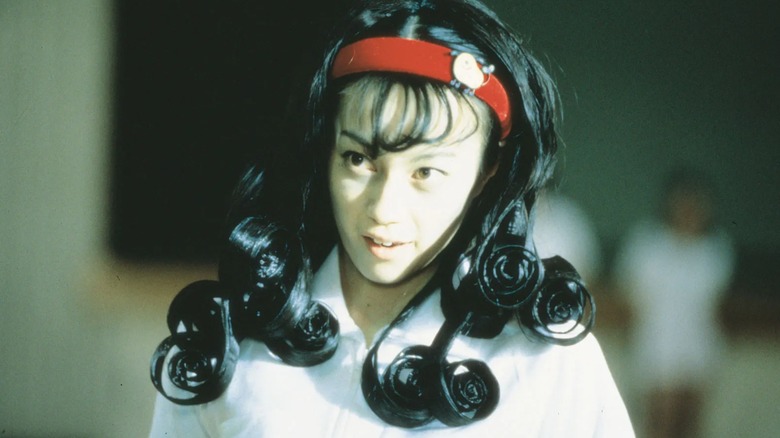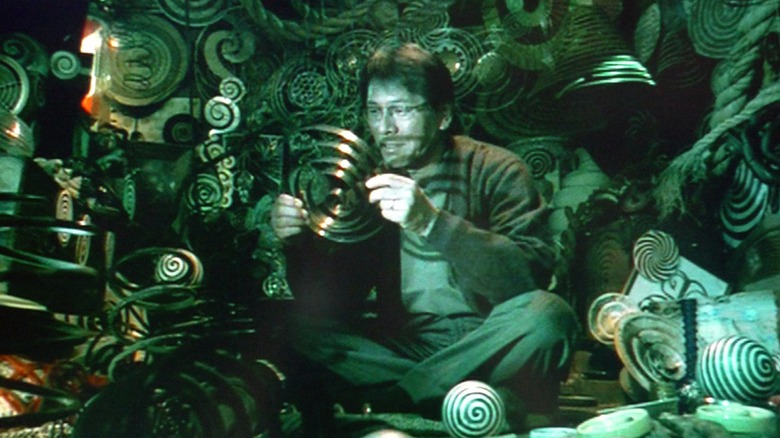Uzumaki Had A Live-Action Movie Long Before Adult Swim's Failed Horror Anime
This post contains major spoilers for "Uzumaki."
The quaint Japanese town of Kurouzu-cho is the focal point of Junji Ito's acclaimed horror manga, "Uzumaki." When we're first introduced to Kurouzu-cho through the eyes of high schooler Kirie, her perception of this seemingly quiet and ordinary town lulls us into a false sense of security. Seconds later, her boyfriend Shuichi shatters this illusion. "I feel dizzy every time I get off at the station platform. This town is driving me insane!" Shuichi exclaims while holding his head in his hands, visibly unsettled by Kurouzu-cho's suffocating air.
As the chapters progress, Shuichi's fears are proven right. A deadly spiral obsession grips the town's inhabitants, starting with Shuichi's own father, who is entranced by anything that naturally mimics a spiral. After studying these dizzying patterns (in objects like coiled spirals and narutomaki) for hours like some devout fanatic, Shuichi's father takes his spiral obsession one step further by mimicking the shape with his contorted body. This extreme introduction of bodily horror seeps into the town's already-heavy atmosphere, infecting anyone who comes into contact with the horrific curse (which seems almost gleefully sentient in its motive to morph and corrupt).
Ito's "Uzumaki" ventures into horrifying absurdities, but this instinct is well-suited to manga as a medium, as it allows intricately detailed worlds to come to life. The monochrome lens through which we see "Uzumaki" is less of a limitation, as Ito's mastery over his horror concepts takes on a haunting quality on paper. When two bodies coil around each other like snakes, mimicking a Double Helix (the structure of DNA), Ito uses dark ink to accentuate the surreal nature of the situation. A similar effect is tricky to achieve in live-action, especially with the introduction of color, which robs Ito's warped world of immersion and believability.
This issue could've been potentially solved by Adult Swim's monochrome anime series "Uzumaki," but it turned out to be a botched, downright insulting adaptation in the end. Fret not, though: We still have "Spiral," the 2000 live-action film adaptation that makes up for its flaws by leaning sincerely toward the twisted, illogical nature of Ito's "Uzumaki."
Spiral is a deliciously twisted and experimental take on Ito's Uzumaki
The problems that plague the Adult Swim anime boil down to unfortunate behind-the-scenes developments, including the show swapping directors and studios after a promising season premiere. What followed was a rush job that failed to capture the essence of Ito's evocative art, as the animation lacked care or detail. The result was an adaptation with a jarring, unfinished quality that made everything look terrible.
This is truly disappointing, as the Adult Swim series initially had the good idea to translate Ito's monochrome panels using motion capture and CGI-aided animation, but it ended up thwarting its own potential by compromising on quality control. In comparison, the 2000 live-action "Spiral" emerges as a competent, faithful companion piece to Ito's manga. While it is unable to recreate the efficacy of a horror manga due to the limitations of the live-action medium, it makes up for this by adopting a Lynchian sensibility that isn't afraid to push the limits of what looks terrifying onscreen. Combine this with an effective use of the J-horror curse trope, and we have a fun, weird little film that comes close to the disorienting vertigo that "Uzumaki" evokes.
Just like in the manga, "Spiral" throws Kirie (Eriko Hatsune) and Shuichi (Fhi Fan) into a whirlwind of bizarre happenings, but nothing feels stranger than the spine-chilling events they're unwittingly swept up in. A vibrated, blue-green tinge bleeds into every frame, conveying the fact that the movie's fictional world is as odd and ominous as it gets. Here, a woman traumatized by the spiral curse stabs her own ears because the cochlea (inner ear) is a spiral cavity, while Kirie's straight hair grows and mutates endlessly to form sentient, nutrient-sapping spirals. But even that's less shocking than the culmination of Kurouzu-cho's fate, as we soon realize there's no hope left in this deteriorating wasteland. In both "Uzumaki" and "Spiral," humans give in to their hardwired tendency to self-destruct.
Although "Spiral" doesn't fully satisfy the itch for a competent "Uzumaki" adaptation, it holds its own by fashioning a delightfully eccentric identity for itself — one that echoes Ito's best impulses as an artist.

